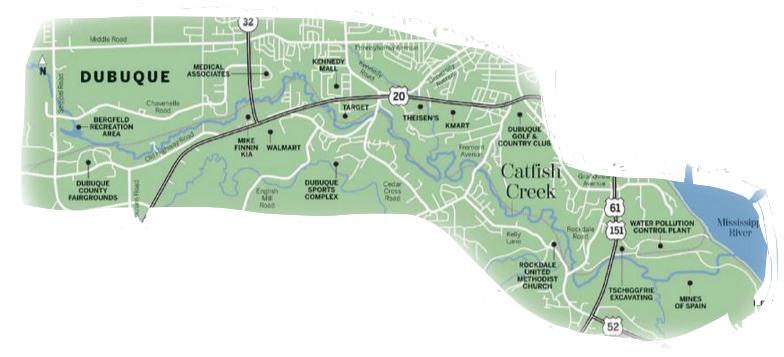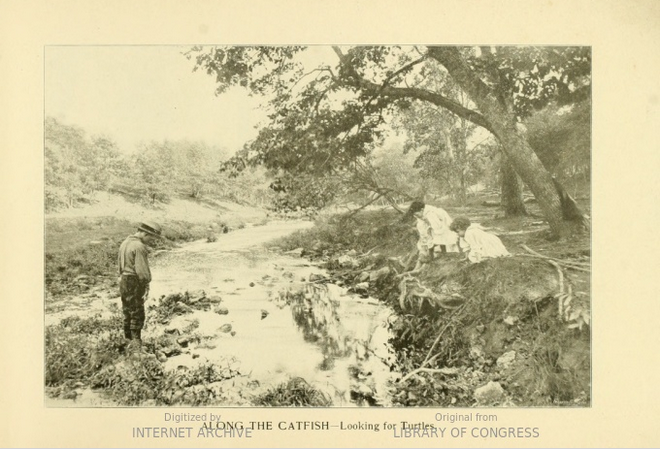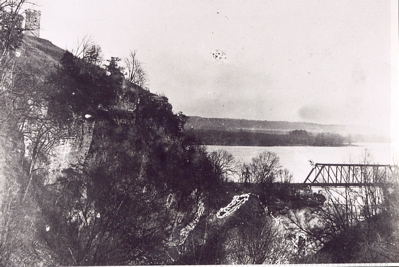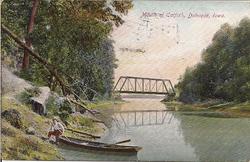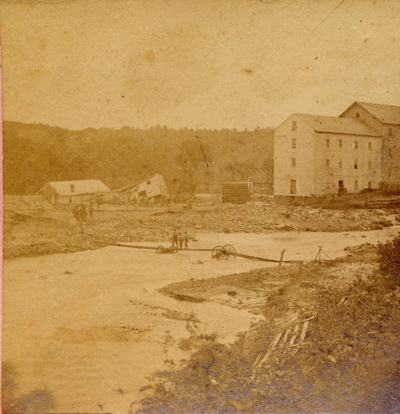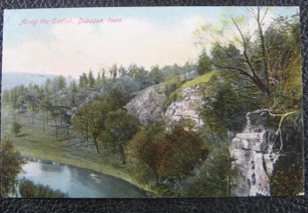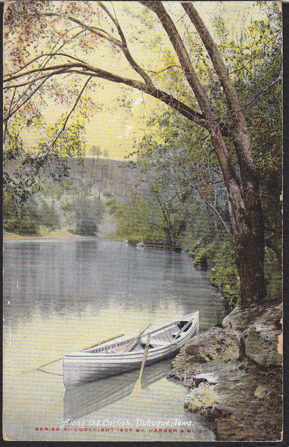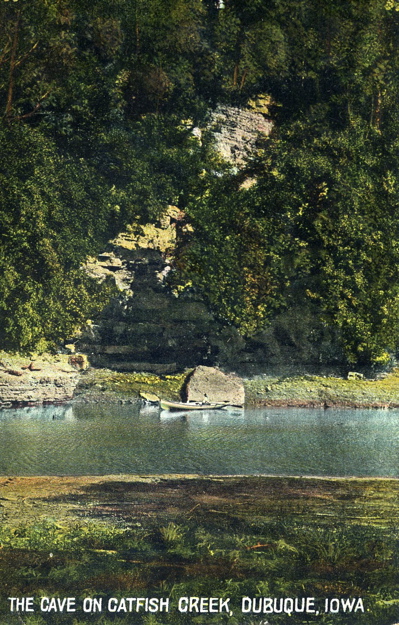Encyclopedia Dubuque
"Encyclopedia Dubuque is the online authority for all things Dubuque, written by the people who know the city best.”
Marshall Cohen—researcher and producer, CNN
Affiliated with the Local History Network of the State Historical Society of Iowa, and the Iowa Museum Association.
CATFISH CREEK: Difference between revisions
No edit summary |
No edit summary |
||
| Line 6: | Line 6: | ||
CATFISH CREEK. A minor tributary of the [[MISSISSIPPI RIVER]], Catfish Creek rises west and southwest of Dubuque, Iowa. The Middle Fork flows under and then parallel to U.S. Highway 20. The remaining forks of the creek are all south of Highway 52. Swiss Valley Park, maintained by Dubuque County, is on the main fork. The section of the creek in Swiss Valley is a designated trout stream. (1) The portion running through the Mines of Spain State Recreation Area has increased in popularity for “quiet water activities” such as canoeing, kayaking, water-based eco-tours and wildlife watching. | CATFISH CREEK. A minor tributary of the [[MISSISSIPPI RIVER]], Catfish Creek rises west and southwest of Dubuque, Iowa. The Middle Fork flows under and then parallel to U.S. Highway 20. The remaining forks of the creek are all south of Highway 52. Swiss Valley Park, maintained by Dubuque County, is on the main fork. The section of the creek in Swiss Valley is a designated trout stream. (1) The portion running through the Mines of Spain State Recreation Area has increased in popularity for “quiet water activities” such as canoeing, kayaking, water-based eco-tours and wildlife watching. | ||
[[Image:cfcreek.jpg|left|thumb|250px|Postcard from the early 1900s.]]In the late 1700s, the [[MESKWAKIES]] located a village near the mouth of Catfish Creek and mined [[LEAD]] in the area. In 1788 they allowed [[DUBUQUE, Julien|Julien DUBUQUE]] to live along the stream and operate the mines. Near the mouth of the stream, his settlement included a smelter and blacksmith shop. | [[Image:cfcreek.jpg|left|thumb|250px|Postcard from the early 1900s.]] | ||
In the late 1700s, the [[MESKWAKIES]] located a village near the mouth of Catfish Creek and mined [[LEAD]] in the area. In 1788 they allowed [[DUBUQUE, Julien|Julien DUBUQUE]] to live along the stream and operate the mines. Near the mouth of the stream, his settlement included a smelter and blacksmith shop. | |||
[[Image:imp912.jpg|right|thumb|250px|Rockdale disaster.]]On the evening of June 4, 1876, a downpour of rain caused Catfish Creek to surge out of its banks to a depth of perhaps twenty-feet and a width of hundreds of feet. The village of [[ROCKDALE]] suffered the loss of two stores, several houses, a hotel, saloon, post office, and blacksmith shop. Reports stated that forty-two people died with survivors found in tree tops. | [[Image:imp912.jpg|right|thumb|250px|Rockdale disaster.]] | ||
On the evening of June 4, 1876, a downpour of rain caused Catfish Creek to surge out of its banks to a depth of perhaps twenty-feet and a width of hundreds of feet. The village of [[ROCKDALE]] suffered the loss of two stores, several houses, a hotel, saloon, post office, and blacksmith shop. Reports stated that forty-two people died with survivors found in tree tops. | |||
The Catfish Creek Watershed is a 46,300 acre watershed consisting of the City of Dubuque, the City of Asbury, and the City of Peosta. There are five sub-watersheds within the Catfish Creek Watershed. These include: the North Fork, Middle Fork, South Fork, Granger Creek, and the main stem of Catfish Creek. The Iowa Department of Natural Resources (IDNR) has labeled Upper Catfish Creek a cold-water Class "B"(CW) stream from the Swiss Valley Park Campgrounds and south approximately 3 miles. This stream has brown trout naturally reproducing within it--one of only thirty such streams in Iowa. Along with the urban area the stream impacts, the creek meanders through the three important natural resources within the watershed, Swiss Valley Park, the Swiss Valley Nature Preserve, and the Mines of Spain State Park. These areas are managed by both the Dubuque County Conservation Board and the Iowa Department of Natural Resources, and attract over 380,000 users annually. ( | The Catfish Creek Watershed is a 46,300 acre watershed consisting of the City of Dubuque, the City of Asbury, and the City of Peosta. There are five sub-watersheds within the Catfish Creek Watershed. These include: the North Fork, Middle Fork, South Fork, Granger Creek, and the main stem of Catfish Creek. (2) The Iowa Department of Natural Resources (IDNR) has labeled Upper Catfish Creek a cold-water Class "B"(CW) stream from the Swiss Valley Park Campgrounds and south approximately 3 miles. This stream has brown trout naturally reproducing within it--one of only thirty such streams in Iowa. Along with the urban area the stream impacts, the creek meanders through the three important natural resources within the watershed, Swiss Valley Park, the Swiss Valley Nature Preserve, and the Mines of Spain State Park. These areas are managed by both the Dubuque County Conservation Board and the Iowa Department of Natural Resources, and attract over 380,000 users annually. (3) | ||
In 1974 a 10-20 acre man-made lake was considered west of the Dubuque city limits. By damming the North Fork of the creek at the junction of the Joseph Siegert farm and the city limits just north of Pennsylvania Avenue, a trail/park could be created. The plan would also serve to solve drainage and flooding problems. ( | In 1974 a 10-20 acre man-made lake was considered west of the Dubuque city limits. By damming the North Fork of the creek at the junction of the Joseph Siegert farm and the city limits just north of Pennsylvania Avenue, a trail/park could be created. The plan would also serve to solve drainage and flooding problems. (4) The dam was planned in conjunction with what was later called the [[NORTHWEST ARTERIAL]]. | ||
In 1997 Catfish Creek was the focus of an environmental checkup by the Iowa Department of Natural Resources. Draining about seventy miles of eastern Dubuque County known as Swiss Valley, Catfish Creek has three major tributaries--South, Middle and North Forks of Catfish Creek as well as Granger Creek to the south. Sections of the creek flow through pipes under Kennedy Road and Pennsylvania Avenue. The survey gave biologists a look at the fish distribution--an indicator of water quality. Species found included carp, sunfish, catfish, sauger and bass. Tom Boland, a DNR biologist, was then in the process of raising the visibility of the creek and its watershed by proposing the creation of a Catfish Creek Coalition. ( | In 1997 Catfish Creek was the focus of an environmental checkup by the Iowa Department of Natural Resources. Draining about seventy miles of eastern Dubuque County known as Swiss Valley, Catfish Creek has three major tributaries--South, Middle and North Forks of Catfish Creek as well as Granger Creek to the south. Sections of the creek flow through pipes under Kennedy Road and Pennsylvania Avenue. The survey gave biologists a look at the fish distribution--an indicator of water quality. Species found included carp, sunfish, catfish, sauger and bass. Tom Boland, a DNR biologist, was then in the process of raising the visibility of the creek and its watershed by proposing the creation of a Catfish Creek Coalition. (5) Local educators were to be asked for copies of studies they had conducted on water quality, flow, and invertebrates. (6) Officials with the Dubuque County Conservation Society stated at the time that it had lobbied for protection of the creek since 1978. (7) | ||
Landowners and residents working with the Upper Catfish Creek Watershed Project began conservation practices and other changes to improve their farming operations, land, and creek. In 2007 a $7,500 grant was awarded by the Iowa Department of Natural Resources to help the Dubuque County Conservation Board control storm water at the Swiss Valley Nature Center. The grant money helped install a pervious parking area and a permeable grass paver walkway to reduce storm water runoff entering the creek. | Landowners and residents working with the Upper Catfish Creek Watershed Project began conservation practices and other changes to improve their farming operations, land, and creek. In 2007 a $7,500 grant was awarded by the Iowa Department of Natural Resources to help the Dubuque County Conservation Board control storm water at the Swiss Valley Nature Center. The grant money helped install a pervious parking area and a permeable grass paver walkway to reduce storm water runoff entering the creek. | ||
In July 2012 applications accepted for two positions to represent the City of Dubuque on the newly formed Catfish Creek Watershed Management Authority (CCWMA). The CCWMA, formed by an agreement through a grant contract with the Iowa Economic Development Authority, invited the Catfish Creek Watershed political subdivisions of Dubuque County and the cities of Dubuque, Asbury, Peosta, and Centralia and the Dubuque Soil and Water Conservation District to enter into a joint and cooperative agreement for the establishment of a Catfish Creek Watershed Authority to effectively plan, communicate, educate, and provide guidance for the Catfish Creek Watershed. ( | In July 2012 applications accepted for two positions to represent the City of Dubuque on the newly formed Catfish Creek Watershed Management Authority (CCWMA). The CCWMA, formed by an agreement through a grant contract with the Iowa Economic Development Authority, invited the Catfish Creek Watershed political subdivisions of Dubuque County and the cities of Dubuque, Asbury, Peosta, and Centralia and the Dubuque Soil and Water Conservation District to enter into a joint and cooperative agreement for the establishment of a Catfish Creek Watershed Authority to effectively plan, communicate, educate, and provide guidance for the Catfish Creek Watershed. (8) In October the CWMA received a $187,330 grant by the Iowea Economic Development Authority and the Department of Natural Resources. The Dubuque project was one of three awarded funds by the state. The money was to be used to form a comprehensive plant to improve water quality and reduce flood risks in the Catfish Creek basin. The CWMA would match the money and have 24 months to complete a plan to deaol with impairments in the waterway. (9) | ||
To educate and engage the public on water quality and the Catfish Creek Watershed, the City of Dubuque City, Catfish Creek Watershed Management Authority, Dubuque County Conservation Board, Dubuque Metropolitan Area Solid Waste Agency, Dubuque Soil & Water Conservation District, and the [[NATIONAL MISSISSIPPI RIVER MUSEUM AND AQUARIUM]] hosted the first annual Catfish Creek Festival on April 26, 2014 at the Swiss Valley Park Walnut Pavilion, 13606 Swiss Valley Rd. Festivities began with an educational exercise on water quality monitoring, followed by a stream clean-up activity and a presentation by the Catfish Creek Watershed Management Authority. ( | To educate and engage the public on water quality and the Catfish Creek Watershed, the City of Dubuque City, Catfish Creek Watershed Management Authority, Dubuque County Conservation Board, Dubuque Metropolitan Area Solid Waste Agency, Dubuque Soil & Water Conservation District, and the [[NATIONAL MISSISSIPPI RIVER MUSEUM AND AQUARIUM]] hosted the first annual Catfish Creek Festival on April 26, 2014 at the Swiss Valley Park Walnut Pavilion, 13606 Swiss Valley Rd. Festivities began with an educational exercise on water quality monitoring, followed by a stream clean-up activity and a presentation by the Catfish Creek Watershed Management Authority. (10) | ||
In September 2017 the Catfish Creek Watershed Management Authority and the City of Dubuque began accepting applications for conservation grants. The new cost-share program offered financial incentives to watershed landowners to install conservation practices on their land. The Authority had an estimated $100,000 to invest within the 46,000-acre watershed. ( | In September 2017 the Catfish Creek Watershed Management Authority and the City of Dubuque began accepting applications for conservation grants. The new cost-share program offered financial incentives to watershed landowners to install conservation practices on their land. The Authority had an estimated $100,000 to invest within the 46,000-acre watershed. (11) In 2018 Green Dubuque, an environmental organization, worked with the CCWMA to implement conservation practices on local farms. Paul Schultz, president of the organization, however stated his belief that some sort of regulation would be needed if significant progress in reducing nitrogen pollution was to be realized. (12) | ||
Dubuque County supervisors in February 2019 approved expanding testing of local water sources. Voting unanimously, the supervisors approved spending $21,850 on quarterly testing of watershed samples from thirty different locations in the county. Testing conducted by the [[UNIVERSITY OF DUBUQUE]] would focus on nitrates, phosphate, chloride and ammonium commonly introduced by water runoff. Five surface water sources would be tested throughout the year--Catfish Creek, Whitewater Ceek, Little Maquoketa Creek, Bloody Run Creek and Bankston Creek. The University of Dubuque had been testing water samples from Catfish and Whitewater creeks. In 2017 Catfish showed above-average amounts of phosphate and nitrate. ( | Dubuque County supervisors in February 2019 approved expanding testing of local water sources. Voting unanimously, the supervisors approved spending $21,850 on quarterly testing of watershed samples from thirty different locations in the county. Testing conducted by the [[UNIVERSITY OF DUBUQUE]] would focus on nitrates, phosphate, chloride and ammonium commonly introduced by water runoff. Five surface water sources would be tested throughout the year--Catfish Creek, Whitewater Ceek, Little Maquoketa Creek, Bloody Run Creek and Bankston Creek. The University of Dubuque had been testing water samples from Catfish and Whitewater creeks. In 2017 Catfish showed above-average amounts of phosphate and nitrate. (13) | ||
--- | --- | ||
| Line 32: | Line 34: | ||
1. Upper Catfish Creek Watershed Project. Online: http://www.dubuqueswcd.org/page4.html | 1. Upper Catfish Creek Watershed Project. Online: http://www.dubuqueswcd.org/page4.html | ||
2. | 2. Reber, Craig, "Going with the Flow," ''Telegraph Herald'', October 14, 2012, p. 1 | ||
3. | 3. Upper Catfish Creek..." | ||
4. | 4. Fyten, David. "City Mulls Plan to Build Lake," ''Telegraph Herald'', April 17, 1974, p. 1 | ||
5. Reber, Craig. " | 5. Reber, Craig. "Biologists Hopeful of Catfish's Future," ''Telegraph Herald'', November 5, 1997, p. 3A | ||
6. | 6. Reber, Craig. "Biologist: Catfish Creek Deserves Protection," ''Telegraph Herald'', September 3, 1997, p. 1. Online: https://news.google.com/newspapers?nid=aEyKTaVlRPYC&dat=19970903&printsec=frontpage&hl=en | ||
7. | 7. Ibid. | ||
8. | 8. Reber, p. 6A | ||
9. News Release, City of Dubuque, July 6, 2012, Online: http://www.cityofdubuque.org/ArchiveCenter/ViewFile/Item/2961 | |||
10. News Release, City of Dubuque, April 7, 2014. Online: http://www.cityofdubuque.org/ArchiveCenter/ViewFile/Item/4247 | |||
11. "Catfish Creek Water Authority Accepting Applications for Conservation Grants," ''Telegraph Herald'', September 15, 2017, p. 6B | |||
12. Kruse, John, "Report: Iowa Farms Contribute More to Gulf Pollution," ''Telegraph Herald'', August 6, 2018, p. 3A | |||
13. Kruse, John, "Dubuque County Supervisors Approve Funding for Additional Water Testing," ''Telegraph Herald'', February 24, 2019, p. 15A | |||
[[Image:catfish-3.png|left|thumb|250px|]] | [[Image:catfish-3.png|left|thumb|250px|]] | ||
Revision as of 21:29, 11 March 2019
CATFISH CREEK. A minor tributary of the MISSISSIPPI RIVER, Catfish Creek rises west and southwest of Dubuque, Iowa. The Middle Fork flows under and then parallel to U.S. Highway 20. The remaining forks of the creek are all south of Highway 52. Swiss Valley Park, maintained by Dubuque County, is on the main fork. The section of the creek in Swiss Valley is a designated trout stream. (1) The portion running through the Mines of Spain State Recreation Area has increased in popularity for “quiet water activities” such as canoeing, kayaking, water-based eco-tours and wildlife watching.
In the late 1700s, the MESKWAKIES located a village near the mouth of Catfish Creek and mined LEAD in the area. In 1788 they allowed Julien DUBUQUE to live along the stream and operate the mines. Near the mouth of the stream, his settlement included a smelter and blacksmith shop.
On the evening of June 4, 1876, a downpour of rain caused Catfish Creek to surge out of its banks to a depth of perhaps twenty-feet and a width of hundreds of feet. The village of ROCKDALE suffered the loss of two stores, several houses, a hotel, saloon, post office, and blacksmith shop. Reports stated that forty-two people died with survivors found in tree tops.
The Catfish Creek Watershed is a 46,300 acre watershed consisting of the City of Dubuque, the City of Asbury, and the City of Peosta. There are five sub-watersheds within the Catfish Creek Watershed. These include: the North Fork, Middle Fork, South Fork, Granger Creek, and the main stem of Catfish Creek. (2) The Iowa Department of Natural Resources (IDNR) has labeled Upper Catfish Creek a cold-water Class "B"(CW) stream from the Swiss Valley Park Campgrounds and south approximately 3 miles. This stream has brown trout naturally reproducing within it--one of only thirty such streams in Iowa. Along with the urban area the stream impacts, the creek meanders through the three important natural resources within the watershed, Swiss Valley Park, the Swiss Valley Nature Preserve, and the Mines of Spain State Park. These areas are managed by both the Dubuque County Conservation Board and the Iowa Department of Natural Resources, and attract over 380,000 users annually. (3)
In 1974 a 10-20 acre man-made lake was considered west of the Dubuque city limits. By damming the North Fork of the creek at the junction of the Joseph Siegert farm and the city limits just north of Pennsylvania Avenue, a trail/park could be created. The plan would also serve to solve drainage and flooding problems. (4) The dam was planned in conjunction with what was later called the NORTHWEST ARTERIAL.
In 1997 Catfish Creek was the focus of an environmental checkup by the Iowa Department of Natural Resources. Draining about seventy miles of eastern Dubuque County known as Swiss Valley, Catfish Creek has three major tributaries--South, Middle and North Forks of Catfish Creek as well as Granger Creek to the south. Sections of the creek flow through pipes under Kennedy Road and Pennsylvania Avenue. The survey gave biologists a look at the fish distribution--an indicator of water quality. Species found included carp, sunfish, catfish, sauger and bass. Tom Boland, a DNR biologist, was then in the process of raising the visibility of the creek and its watershed by proposing the creation of a Catfish Creek Coalition. (5) Local educators were to be asked for copies of studies they had conducted on water quality, flow, and invertebrates. (6) Officials with the Dubuque County Conservation Society stated at the time that it had lobbied for protection of the creek since 1978. (7)
Landowners and residents working with the Upper Catfish Creek Watershed Project began conservation practices and other changes to improve their farming operations, land, and creek. In 2007 a $7,500 grant was awarded by the Iowa Department of Natural Resources to help the Dubuque County Conservation Board control storm water at the Swiss Valley Nature Center. The grant money helped install a pervious parking area and a permeable grass paver walkway to reduce storm water runoff entering the creek.
In July 2012 applications accepted for two positions to represent the City of Dubuque on the newly formed Catfish Creek Watershed Management Authority (CCWMA). The CCWMA, formed by an agreement through a grant contract with the Iowa Economic Development Authority, invited the Catfish Creek Watershed political subdivisions of Dubuque County and the cities of Dubuque, Asbury, Peosta, and Centralia and the Dubuque Soil and Water Conservation District to enter into a joint and cooperative agreement for the establishment of a Catfish Creek Watershed Authority to effectively plan, communicate, educate, and provide guidance for the Catfish Creek Watershed. (8) In October the CWMA received a $187,330 grant by the Iowea Economic Development Authority and the Department of Natural Resources. The Dubuque project was one of three awarded funds by the state. The money was to be used to form a comprehensive plant to improve water quality and reduce flood risks in the Catfish Creek basin. The CWMA would match the money and have 24 months to complete a plan to deaol with impairments in the waterway. (9)
To educate and engage the public on water quality and the Catfish Creek Watershed, the City of Dubuque City, Catfish Creek Watershed Management Authority, Dubuque County Conservation Board, Dubuque Metropolitan Area Solid Waste Agency, Dubuque Soil & Water Conservation District, and the NATIONAL MISSISSIPPI RIVER MUSEUM AND AQUARIUM hosted the first annual Catfish Creek Festival on April 26, 2014 at the Swiss Valley Park Walnut Pavilion, 13606 Swiss Valley Rd. Festivities began with an educational exercise on water quality monitoring, followed by a stream clean-up activity and a presentation by the Catfish Creek Watershed Management Authority. (10)
In September 2017 the Catfish Creek Watershed Management Authority and the City of Dubuque began accepting applications for conservation grants. The new cost-share program offered financial incentives to watershed landowners to install conservation practices on their land. The Authority had an estimated $100,000 to invest within the 46,000-acre watershed. (11) In 2018 Green Dubuque, an environmental organization, worked with the CCWMA to implement conservation practices on local farms. Paul Schultz, president of the organization, however stated his belief that some sort of regulation would be needed if significant progress in reducing nitrogen pollution was to be realized. (12)
Dubuque County supervisors in February 2019 approved expanding testing of local water sources. Voting unanimously, the supervisors approved spending $21,850 on quarterly testing of watershed samples from thirty different locations in the county. Testing conducted by the UNIVERSITY OF DUBUQUE would focus on nitrates, phosphate, chloride and ammonium commonly introduced by water runoff. Five surface water sources would be tested throughout the year--Catfish Creek, Whitewater Ceek, Little Maquoketa Creek, Bloody Run Creek and Bankston Creek. The University of Dubuque had been testing water samples from Catfish and Whitewater creeks. In 2017 Catfish showed above-average amounts of phosphate and nitrate. (13)
---
Source:
1. Upper Catfish Creek Watershed Project. Online: http://www.dubuqueswcd.org/page4.html
2. Reber, Craig, "Going with the Flow," Telegraph Herald, October 14, 2012, p. 1
3. Upper Catfish Creek..."
4. Fyten, David. "City Mulls Plan to Build Lake," Telegraph Herald, April 17, 1974, p. 1
5. Reber, Craig. "Biologists Hopeful of Catfish's Future," Telegraph Herald, November 5, 1997, p. 3A
6. Reber, Craig. "Biologist: Catfish Creek Deserves Protection," Telegraph Herald, September 3, 1997, p. 1. Online: https://news.google.com/newspapers?nid=aEyKTaVlRPYC&dat=19970903&printsec=frontpage&hl=en
7. Ibid.
8. Reber, p. 6A
9. News Release, City of Dubuque, July 6, 2012, Online: http://www.cityofdubuque.org/ArchiveCenter/ViewFile/Item/2961
10. News Release, City of Dubuque, April 7, 2014. Online: http://www.cityofdubuque.org/ArchiveCenter/ViewFile/Item/4247
11. "Catfish Creek Water Authority Accepting Applications for Conservation Grants," Telegraph Herald, September 15, 2017, p. 6B
12. Kruse, John, "Report: Iowa Farms Contribute More to Gulf Pollution," Telegraph Herald, August 6, 2018, p. 3A
13. Kruse, John, "Dubuque County Supervisors Approve Funding for Additional Water Testing," Telegraph Herald, February 24, 2019, p. 15A


